第5章 予算編成と経費管理
レッスンの学習目標:
導入: Budgeting and expense management are fundamental aspects of personal finance. This chapter explores how to create a budget that aligns with both short-term and long-term financial goals, including the allocation for an emergency fund, and addresses the dynamics of consumer decisions and
their broader impacts.
- Develop a Budget: Learn different budgeting methods like the 50/30/20 budget, envelope
budgeting, and zero-based budgeting. Understand how to allocate funds to fixed expenses,
variable expenses, and savings to achieve financial goals. - Manage Expenses: Gain strategies for controlling spending by differentiating between
necessary and discretionary expenses. Learn how to adjust budgets to accommodate life changes and maintain financial stability. - Make Informed Consumer Decisions: Understand the process for making informed
consumer decisions by considering factors like price, product alternatives, budget constraints,
and societal impacts.
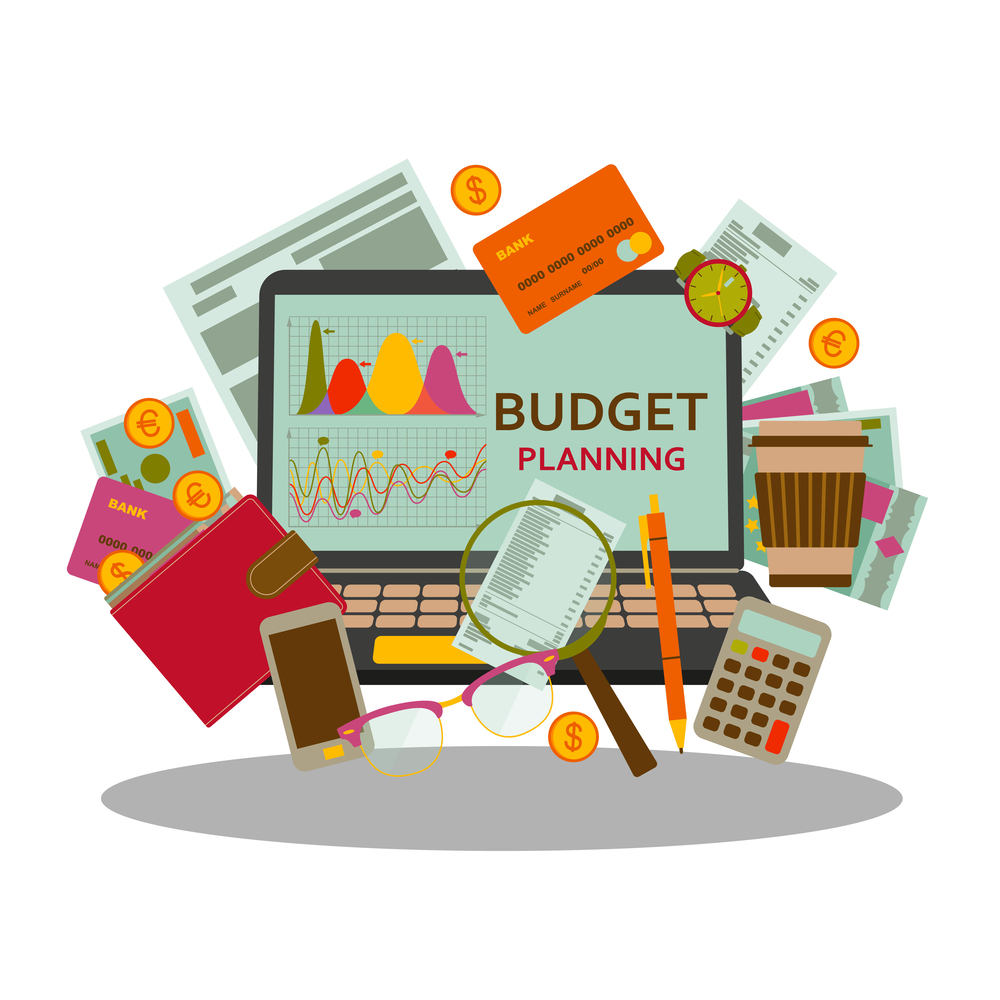
形: A flat style modern vector illustration of budget planning, featuring characters engaged in financial activities with graphs and monetary symbols.
ソース: シャッターストック
Introduction to Budgeting and Expense Management
Budgeting and expense management are fundamental aspects of personal finance. This chapter explores how to create a budget that aligns with both short-term and long-term financial goals, including the allocation for an emergency fund, and addresses the dynamics of consumer decisions and their broader impacts. Additionally, we’ll delve into the essence of saving versus investing, revising budgets to accommodate life changes, and the significance of understanding cash flow and financial charges.
Developing a Budget
There are various budgeting methods to choose from, each with its own advantages and drawbacks. It’s essential to find the method that best suits your needs and preferences. Here are three popular budgeting methods:
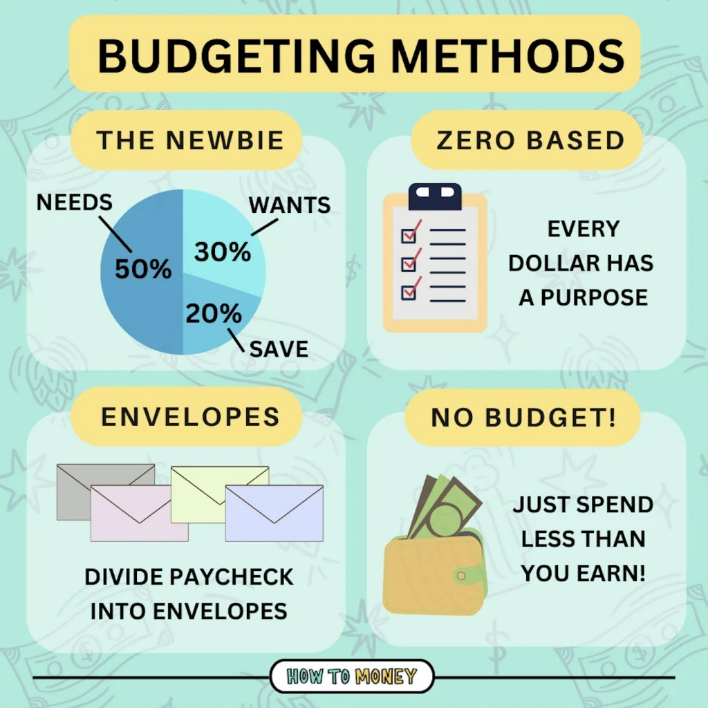
図のタイトル: Types of Budgeting Methods
ソース: How to Money
説明: The image illustrates various budgeting methods that cater to different preferences and financial situations. It simplifies the concept of budgeting, making it more approachable, and explains methods such as the 50/30/20 budget, envelope budgeting, zero-based budgeting, and the no-budget budget, each designed to help individuals manage their finances effectively.
重要なポイント:
- 50/30/20 Budget: A simple approach where 50% of income is allocated for needs, 30% for wants, and 20% towards savings or debt paydown
- Envelope Budgeting: A method where cash is allocated into physical envelopes for specific categories. Spending is limited to the cash available in each envelope
- Zero-Based Budget: Every dollar earned is assigned a specific purpose, ensuring that the budget balances to zero at the end of the month.
The No-Budget Budget: Suitable for high-income earners with good financial habits. The focus is on earning more than spending and investing the difference.
応用: Different budgeting methods cater to various personality types and financial situations. Understanding and choosing the right approach can empower individuals to manage their finances effectively, ensuring they live within their means and achieve their financial goals. Whether one is looking to curb overspending, allocate funds efficiently, or simply gain better control over their finances, these methods offer structured ways to achieve those objectives.
Budgeting involves tracking income, allocating funds to various expenses, and setting aside savings to achieve financial goals. A well-crafted budget includes:
- Fixed Expenses: Recurring costs such as rent or mortgage, loan payments, and insurance.
- Variable Expenses: Costs that fluctuate, like groceries, utilities, and entertainment.
- Savings: Funds earmarked for future use, including emergency funds and long-term savings goals.
- Emergency Fund: A crucial part of financial planning designed to cover unexpected expenses, such as medical emergencies or car repairs.
Example Scenario: Jamie earns $3,000 monthly and wants to save for a vacation while covering living expenses. A budget might allocate $1,000 to rent, $300 to groceries, $200 to utilities, $400 to loan payments, $100 to entertainment, and $600 to an emergency fund, illustrating a balanced approach to managing fixed and variable costs and prioritizing savings.
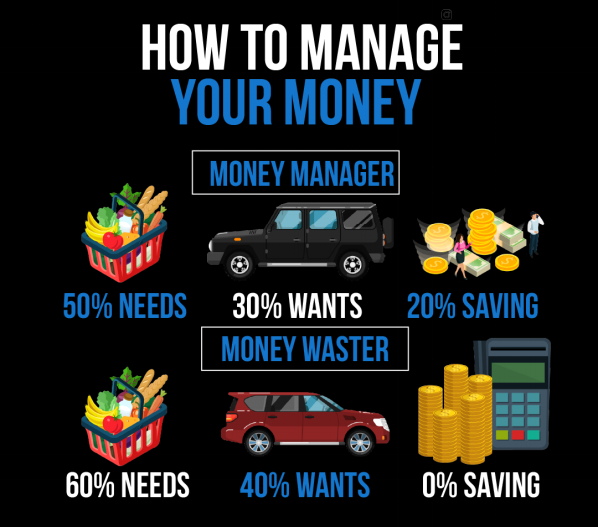
形: The infographic presents a simple guide on “How to Manage Your Money,” contrasting two types of financial behaviors: Money Manager and Money Waster. It advocates for the 50/30/20 budgeting rule, where 50% of your income should go to needs, 30% to wants, and 20% to savings. In contrast, a Money Waster is depicted as someone who spends 60% on needs and 40% on wants, leaving 0% for savings. This visual serves as a budgeting strategy to encourage disciplined spending and saving habits. For practical use, users should evaluate their current spending patterns and adjust their budgets to align with the 50/30/20 rule to ensure they are saving adequately for the future.
出典: カスタム インフォグラフィック
Making Informed Consumer Decisions
Consumer decisions are shaped by factors like price, product alternatives, budget constraints, and the potential societal and environmental impacts.
Process for Making Informed Decisions:
- Research: Gather information about the product and alternatives.
- Budget: Consider how the purchase fits into your budget.
- Impact: Evaluate the potential effects on the environment and society.
Example: Opting for an electric vehicle over a gasoline car can be influenced by long-term savings on fuel, environmental benefits, and available tax incentives, despite a higher initial cost.
Consumer Decision Factors
Product Selected: Electric Vehicle (EV)
Factors Influencing Purchase Decision:
- Price of Product: The upfront cost of an EV can be higher than that of a gasoline-powered vehicle. However, tax incentives and lower operational costs may offset the initial expense.
- Price of Alternatives: Traditional gasoline vehicles are generally cheaper upfront but have higher fuel and maintenance costs over time.
- Consumer’s Budget and Preferences: A consumer’s ability to afford an EV and their preference for environmentally friendly options play significant roles. Some may prioritize eco-friendliness over cost, while others might focus on long-term savings.
- Impact on Environment, Society, and Economy: Purchasing an EV has a lower environmental impact due to reduced emissions. This choice can also support the growth of the renewable energy sector, influencing societal and economic shifts towards sustainability.
Process for Making an Informed Consumer Decision:
- Research: Gather information on various models, including their features, costs, and reviews.
- Comparison: Compare EVs to traditional vehicles in terms of cost, performance, and suitability for needs.
- Budget Assessment: Evaluate personal finances to determine affordability and consider long-term savings.
- Environmental Impact: Consider the ecological benefits of an EV.
- Final Decision: Choose based on a balanced consideration of above factors.
Effects of Purchasing an EV:
- Positive: Reduces carbon footprint, lowers operational costs, promotes renewable energy industries.
- Negative: Higher initial cost might strain the budget; production and disposal of EV batteries have environmental impacts.
Managing Expenses and Budgeting
Expenses:
- Fixed Expenses: Rent, mortgage, car payments – costs that remain constant each month.
- Variable Expenses: Groceries, utilities, entertainment – costs that can fluctuate.
- Irregular Expenses: Annual insurance premiums, holiday gifts – costs that occur occasionally and can disrupt a regular budget.
My Monthly Budget Example:
- Fixed Expenses: $1,200 rent, $300 car payment, $100 insurance.
- Variable Expenses: $400 groceries, $150 utilities, $100 entertainment.
- Irregular Expenses: Set aside $50 monthly for annual costs like subscriptions or memberships.
- Savings: Aim to save $500 monthly for an emergency fund and future investments.
- Surplus or Deficit: Calculate income minus total expenses (including savings) to determine if you’re living within your means or overspending.
Budgeting Strategies:
- The Envelope System: Allocate cash for variable expenses into categorized envelopes each month. Once the cash in an envelope is gone, no more spending is allowed in that category until the next month.
Keeping Budget Alive: Regularly review and adjust your budget. Track spending, recognize patterns, and make changes to ensure goals are met. Utilize budgeting apps or spreadsheets for real-time tracking and adjustments.
Managing Expenses
To control spending, it’s essential to differentiate between necessary and discretionary expenses. Strategies to reduce unnecessary spending include identifying impulse purchases, utilizing the envelope system for managing cash expenditures, and regularly reviewing spending habits.
Necessary (Essential) Expenses are costs required for basic living and functioning in daily life. These expenses cover the minimum needs for an individual or family to maintain a healthy and safe lifestyle. Necessary expenses typically include:
- Housing: Rent or mortgage payments.
- Utilities: Water, electricity, gas, and sometimes internet service, depending on the need for remote work or education.
- Food: Groceries needed for home-prepared meals.
- Healthcare: Insurance premiums, medical bills, prescriptions, and any ongoing medical treatments.
- Transportation: Costs associated with commuting to work or school, including car payments, public transportation fares, gas, and essential vehicle maintenance.
- Insurance: Necessary insurance policies, including health, auto, and homeowners or renters insurance.
Example of Necessary Expenses: Sarah budgets $1,000 monthly for rent, $200 for utilities, $300 for groceries, $250 for her car payment and gas, and $150 for health insurance. These costs are non-negotiable for her to live safely and comfortably.
Discretionary (Non-Essential) Expenses are costs associated with things people want but do not need to live a basic lifestyle. These expenses often enhance quality of life but can be reduced or eliminated if needed. Discretionary expenses include:
- Entertainment: Money spent on movies, concerts, streaming services, or other recreational activities.
- Dining Out: Expenses for eating at restaurants beyond what is necessary for nutrition.
- Hobbies: Costs related to hobbies or leisure activities, such as crafting materials, sports equipment, or book purchases.
- Travel: Costs for vacations and non-essential travel.
- Luxuries: High-end electronics, designer clothing, and other luxury items that go beyond basic needs.
Example of Discretionary Expenses: Alex enjoys dining out, spending an average of $300 a month at restaurants, subscribes to several streaming services costing $50 monthly, and allocates $200 for hobbies and entertainment. While these enhance his life, they can be adjusted based on his financial goals or situation.
Managing Necessary and Discretionary Expenses: Effective financial planning involves first ensuring that necessary expenses are covered within one’s budget. Any remaining income can then be allocated towards discretionary expenses, savings, and investments. Prioritizing savings and debt repayment over discretionary spending is crucial for long-term financial health. Individuals may need to periodically review their spending habits, especially discretionary expenses, to adjust their budget in response to changes in income or financial goals.
By distinguishing between necessary and discretionary expenses and understanding their impact on overall financial planning, individuals can make informed decisions that align with their priorities and financial objectives, ensuring stability and progress towards their goals.
Creating and Revising Budgets
Budgets need to be flexible to reflect changes in income, life circumstances, and financial goals.
- Short-term Savings: Should cover emergencies and unexpected expenses.
- Long-term Savings: Aimed at future aspirations, such as home ownership or retirement.
Adapting Budgets: Life events, such as a job change or unexpected bills, necessitate budget adjustments to stay on track financially.
例: If Alex experiences a job loss, the budget must be revised to reduce variable expenses and prioritize essential costs and minimal savings until income stabilizes.
- Saving is setting aside money for future use, typically in low-risk, easily accessible Saving vs. Investing accounts.
- Investing involves purchasing assets with the potential for higher returns over time but comes with greater risk.
Understanding the distinction helps in aligning financial strategies with goals, balancing the security of savings with the growth potential of investments.
Designing a Personal Budget
A personal budget should reflect an individual’s unique financial situation, goals, and priorities. It involves:
- Setting Goals: Define clear, achievable objectives.
- Allocating Income: Distribute income across expenses, savings, and investments.
Monitoring and Revising: Regularly review and adjust the budget as circumstances evolve.
Impact of External Factors:
Taxes, inflation, and personal changes (e.g., marriage, children) significantly influence budgetary needs and financial planning.
Preparing a Realistic Personal or Family Budget:
- Identify Income Sources: Calculate total monthly income from all sources.
- List and Categorize Expenses: Separate expenses into fixed, variable, and irregular categories.
- Allocate Funds for Savings: Prioritize setting aside a portion of income for savings and emergency funds.
- Adjust for Surplus or Deficit: If expenses exceed income, look for areas to cut back. If there’s a surplus, allocate extra funds to savings or debt repayment.
- Monitor and Review: Regularly check your budget against actual spending and adjust as needed to stay on track.
Interest and Fees in Money Management
Understanding interest rates and fees associated with spending, borrowing, and saving is crucial. Interest can accumulate on savings, enhancing wealth, or on debts, increasing the cost of borrowed funds.
Calculating Interest:
For instance, a savings account with a 1.5% annual interest rate would yield $150 on a $10,000 balance over one year, whereas a credit card with a 20% interest rate could cost $200 in interest on a $1,000 balance unpaid over the same period.
By mastering the principles of budgeting and expense management, individuals can navigate their financial journey with confidence, making informed decisions that foster stability, growth, and fulfillment.
Changes in Taxes
Impact: An increase in taxes, whether it’s income tax, property tax, or sales tax, directly reduces the amount of disposable income an individual or household has. For example, if income taxes rise, the net income after taxes decreases, leaving less money for spending and saving. Conversely, tax decreases can increase disposable income, providing more room in the budget for other expenses or savings.
Example: Suppose Alex’s effective income tax rate increases due to changes in tax legislation. As a result, his monthly take-home pay decreases. To adjust, Alex might need to reduce his discretionary spending or reevaluate his savings contributions to maintain his financial stability.
インフレーション
Impact: Inflation erodes purchasing power over time, meaning the same amount of money buys fewer goods and services. As prices for essentials like food, housing, and healthcare rise, individuals may find their existing budget no longer covers their needs. This necessitates either finding ways to increase income or adjusting spending habits to accommodate the higher cost of living.
Example: If the annual inflation rate is 3%, and Emily’s salary doesn’t increase, her living expenses will rise, effectively reducing her disposable income. Emily might need to cut back on non-essential spending, seek additional sources of income, or prioritize her spending differently to manage the increased cost of living.
Personal Circumstances
Impact: Life events such as marriage, divorce, the birth of a child, job loss, or receiving an inheritance can significantly affect one’s financial situation and budget. Positive changes may result in increased financial stability, while challenging events might require tightening the budget or reallocating funds to meet new demands.
Example 1: After the birth of their child, Jordan and Taylor realize their current apartment is too small. Moving to a larger place increases their rent, necessitating adjustments in their budget to accommodate this essential expense.
Example 2: Sarah receives a promotion with a substantial pay increase. She decides to increase her retirement savings contributions and start a college fund for her children, reflecting her improved financial situation.
Adjusting to Changes
To adapt to changes in taxes, inflation, and personal circumstances, individuals might need to:
- Review and Adjust Budgets Regularly: Keeping budgets flexible to accommodate changes in income and expenses.
- Prioritize Spending: Focusing on needs over wants, especially during times of financial constraint.
- Seek Opportunities to Increase Income: Exploring side gigs, asking for raises, or acquiring new skills for better-paying jobs.
- Build an Emergency Fund: Providing a financial buffer to help manage unexpected changes or challenges.
Effective budgeting and expense management are key to achieving financial stability and meeting long-term goals. Understanding and applying these principles allows individuals to make informed consumer decisions and maintain a healthy financial lifestyle.
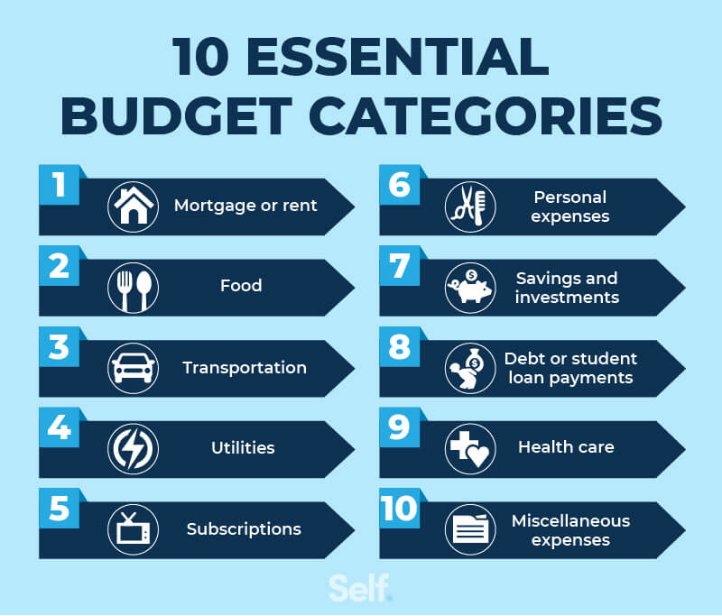
図のタイトル: 10 Essential Budget Categories
ソース: Self.inc
説明:
The image presents a list of ten essential budget categories that individuals should consider when planning their finances. These categories cover a range of expenses and savings areas, helping individuals allocate their funds effectively.
重要なポイント:
- Mortgage or Rent: Allocate funds for housing expenses.
- Savings and Investments: Set aside money for future financial goals and wealth accumulation.
- Debt or Student Loans: Plan for repayment of debts and educational loans.
- Transportation: Budget for commuting, vehicle maintenance, and other transportation-related costs.
- Miscellaneous Expenses: Allocate funds for unforeseen or varied expenses.
- サブスクリプション: Budget for monthly or annual subscription services.
(Note: Some categories from the image might be missing due to incomplete OCR extraction.)
応用:
Having a clear categorization of budget areas is crucial for effective financial planning. By breaking down expenses and savings into specific categories, individuals can gain a better understanding of their financial habits, identify areas for improvement, and make informed decisions. This categorization serves as a foundational guide for anyone looking to establish a comprehensive budget, ensuring that all essential areas are covered and financial goals are met.
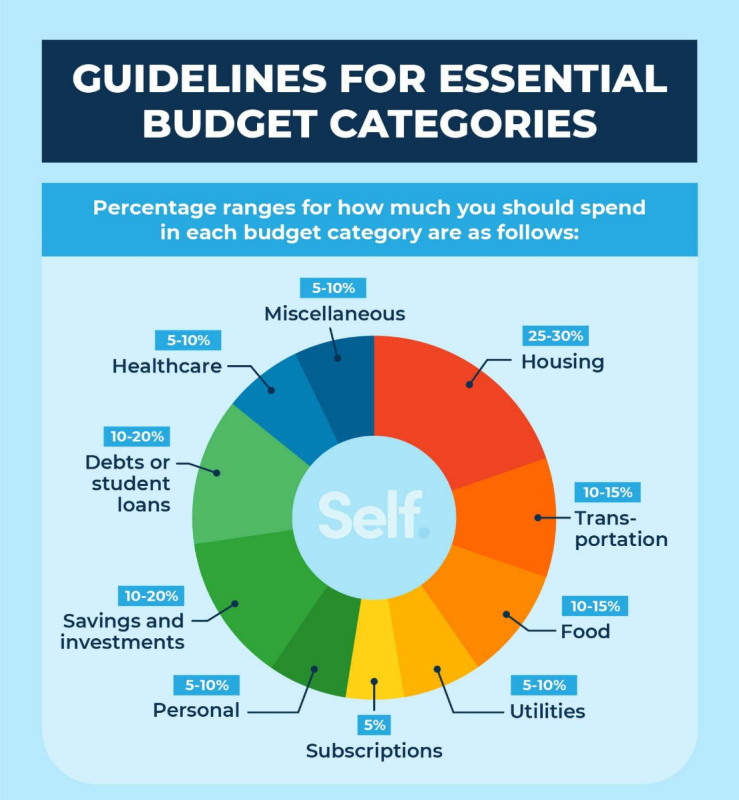
Figure title: Essential Budget Categories for Financial Planning
ソース: Self.inc
説明: The image from Self.inc outlines ten essential budget categories that are critical for effective financial planning. These categories help individuals understand their spending patterns and manage their finances by allocating funds appropriately to areas such as housing, food, transportation, and healthcare.
重要なポイント:
- Housing should generally consume about 30% of income, including associated costs like insurance and taxes.
- Food expenses can range from 10% to 16% of income, with variations based on household size and dietary choices.
- Transportation costs, which include vehicle payments and public transit, should ideally not exceed 15% of monthly income.
- Utility bills can be kept within 5% to 10% of income through energy-saving measures and service plan comparisons.
- Healthcare costs are recommended to be budgeted between 5% to 10%, considering both regular and potential unexpected medical expenses.
応用: By categorizing expenses, individuals can create a structured budget that aligns with their income and financial goals. This approach allows for a clear understanding of where money is being spent and where adjustments can be made to save more or pay off debt. It’s particularly useful for those looking to gain control over their finances and work towards financial stability and independence.
主なレッスン情報:
閉会の辞: Effective budgeting and expense management are key to achieving financial stability
and meeting long-term goals. By mastering budgeting methods, controlling expenses, and making
informed consumer decisions, individuals can ensure a healthy financial lifestyle.
1. Budgeting Methods: Different budgeting methods cater to various financial situations. For example, the 50/30/20 budget allocates 50% of income to needs, 30% to wants, and 20% to
savings or debt repayment, while envelope budgeting involves allocating cash into physical envelopes for specific categories.
2. Expense Management: Controlling expenses requires understanding the difference between necessary (e.g., rent, utilities) and discretionary (e.g., dining out, entertainment) expenses.
Using strategies like the envelope system and regularly reviewing spending habits can help maintain financial stability.
3. 情報に基づいた消費者の意思決定: Making informed decisions involves researching products, comparing alternatives, and considering the long-term impacts on both personal finances and
the environment. For instance, choosing an electric vehicle might have higher upfront costs but offers long-term savings and environmental benefits.
4. Adjusting Budgets: Budgets need to be flexible to reflect changes in income, life
circumstances, and financial goals. Regularly reviewing and adjusting the budget ensures that financial plans remain effective and aligned with current needs.

